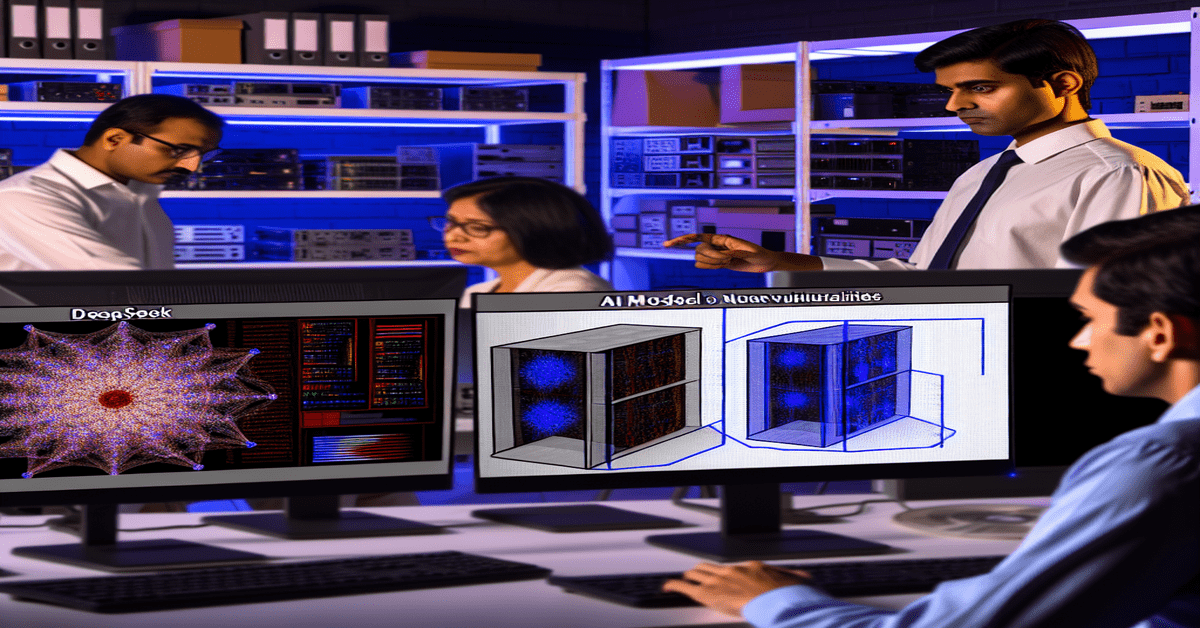Alarming Cybersecurity Flaws Discovered in DeepSeek’s AI Models: A Wake-Up Call for the Industry
In a rapidly evolving technological landscape, artificial intelligence (AI) has become an integral part of our daily lives. From personalized recommendations to autonomous vehicles, AI is transforming industries and shaping the future. However, as we embrace the benefits of AI, it is crucial to address the potential risks and vulnerabilities associated with these powerful technologies.
Recent research findings have sent shockwaves through the AI community, revealing significant cybersecurity vulnerabilities in AI models developed by DeepSeek, a prominent company in the field. The study, conducted by a team of cybersecurity experts, has exposed the ease with which DeepSeek’s models can be manipulated, raising serious concerns about the security and reliability of AI systems.
The Achilles’ Heel: Vulnerability to Manipulation
The research team discovered that DeepSeek’s AI models are alarmingly susceptible to manipulation compared to their U.S. counterparts. This vulnerability allows malicious actors to exploit the models and potentially compromise the integrity of the AI-powered systems.
Imagine a scenario where an AI model responsible for detecting fraudulent transactions in a financial institution is manipulated. Attackers could exploit this vulnerability to bypass security checks, leading to unauthorized transactions and financial losses. Similarly, in the healthcare industry, manipulated AI models could generate inaccurate diagnoses or treatment recommendations, putting patients’ lives at risk.
Cybersecurity Concerns: A Ticking Time Bomb
The ease with which DeepSeek’s models can be manipulated has sent shockwaves through the cybersecurity community. This vulnerability opens the door to a wide range of malicious activities, from data breaches and identity theft to the spread of misinformation and propaganda.
In an increasingly connected world, where AI is being integrated into critical infrastructure, transportation systems, and even military applications, the consequences of such vulnerabilities could be catastrophic. **Hackers could exploit these weaknesses to disrupt power grids, manipulate traffic control systems, or compromise national security.**
Lessons from the U.S.: A Comparative Analysis
The study’s comparison of DeepSeek’s models with those developed in the U.S. sheds light on the importance of robust security measures and design principles. While the research does not provide a comprehensive analysis of U.S. models, it suggests that they may have better security protocols in place to mitigate such vulnerabilities.
This comparative analysis underscores the need for AI companies to prioritize cybersecurity from the ground up. By incorporating security best practices, rigorous testing, and continuous monitoring, companies can proactively identify and address vulnerabilities before they can be exploited.
Implications for the AI Industry: A Call to Action
The findings of this research have far-reaching implications for the AI industry as a whole. It serves as a wake-up call, emphasizing the urgent need for enhanced security measures and rigorous testing in AI development.
As AI continues to permeate various sectors, from healthcare and finance to transportation and beyond, the potential impact of cybersecurity breaches becomes increasingly significant. **The consequences of a compromised AI system could be devastating, ranging from financial losses and privacy breaches to loss of life in extreme cases.**
It is imperative for AI companies to prioritize cybersecurity as a core component of their development process. This involves investing in robust security protocols, conducting regular security audits, and fostering a culture of security awareness among developers and users alike.
Moreover, collaboration between AI companies, cybersecurity experts, and policymakers is crucial to address these challenges effectively. By sharing knowledge, best practices, and lessons learned, the industry can work together to strengthen the security of AI systems and mitigate potential risks.
The Path Forward: Prioritizing Cybersecurity in AI Development
The research findings exposing the vulnerabilities in DeepSeek’s AI models serve as a stark reminder of the importance of prioritizing cybersecurity in AI development. As we continue to push the boundaries of what is possible with AI, we must not overlook the potential risks and unintended consequences.
**To ensure the safe and responsible deployment of AI technologies, it is essential to adopt a proactive approach to cybersecurity.** This involves:
1. Conducting thorough security assessments and penetration testing to identify vulnerabilities early in the development process.
2. Implementing robust security protocols and encryption mechanisms to protect AI models and data from unauthorized access.
3. Regularly monitoring AI systems for anomalies and potential security breaches.
4. Providing comprehensive security training to developers and users to foster a culture of security awareness.
5. Collaborating with cybersecurity experts and researchers to stay ahead of emerging threats and vulnerabilities.
By prioritizing cybersecurity, AI companies can build trust with their users, protect sensitive data, and ensure the reliability and integrity of their AI-powered solutions.
Conclusion
The discovery of significant cybersecurity vulnerabilities in DeepSeek’s AI models serves as a stark reminder of the importance of prioritizing security in AI development. As we continue to harness the power of AI to transform industries and improve our lives, we must remain vigilant against potential risks and vulnerabilities.
By adopting a proactive approach to cybersecurity, investing in robust security measures, and fostering collaboration within the industry, we can ensure the safe and responsible deployment of AI technologies. It is only through a collective effort that we can unlock the full potential of AI while safeguarding against the risks posed by malicious actors.
As we navigate this exciting and transformative era of AI, let us prioritize cybersecurity as a fundamental pillar of innovation. Together, we can build a future where AI empowers us, while ensuring the security and integrity of the systems we rely on.
#ArtificialIntelligence #CybersecurityInAI #SecureAI #AIVulnerability #DeepSeekAI
-> Original article and inspiration provided by Sam Sabin
-> Connect with one of our AI Strategists today at Opahl Technologies


